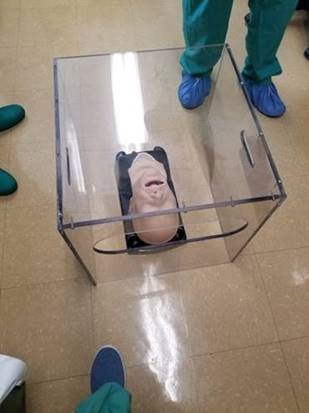COVID-19 ResourcesIntubation Protection Devices Below is a diagram that we used initially for guidance (this was shared from an unknown source). We made 3 so far and had 2 donated to our hospital after a local volunteer saw my post on Facebook (I am not a big social media person, but I shared our hospital’s work to inspire ideas online).
We deviated from the design in our first two builds. Rather than two cutouts, we used a rectangular cutout for the hands. Using saran wrap from the hospital cafeteria, we wrapped the opening and cut slits for the hands. Our measurements are width 20”, height 23”, length 18” on top and 12” on the bottom to taper to fit shoulders. Cut out for arms 12” x 4” with rounded edges. The plexiglass pieces (3/8” thick) were scraps from the construction of emergency negative pressure rooms. These are a bit heavy because of the thickness, so try to use thinner material if possible. Below are pictures demonstrating the intubation boxes, our anesthesia “intubation cart,” including protocols for donning and doffing, and our prototype PVC “negative pressure” tent setup utilizing suction to move air away from the intubater. Holes are drilled on the upper PVC toward the feet to move air in that direction. Suction is connected to an adaptor on the right-hand side. The wrap is to be tucked around the patient and under the bed to create seal. We have to order clear plastic. These builds wouldn’t be possible without Dr. Bob McDonald (Intensivist/Pulmonologist and Chief of Staff, Waterbury Hospital) and Waterbury Hospital’s maintenance team.     
|

